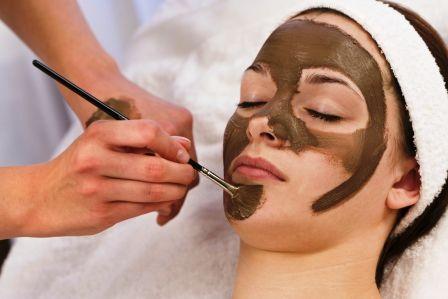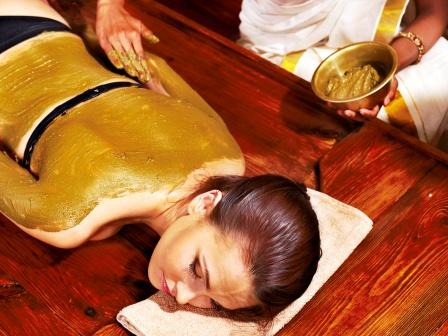Lepa Kalpana: Ayurvedic Dosage Forms For External Application
Article by: Dr.B.K.Prashanth M.D (Ayu), Ph.D
Ayurveda has explained in detail about the usage of different types of medicines for the treatment of diseases. The science has given importance to the usage of external route of medicine. It includes Kalka, Lepa and Malahara (different types of paste). This article will elaborate on these medicaments.
Table of Contents
Kalka preparation video
Kalka:
Preparation method:
It is a soft mass of the herbs prepared by pounding them using mortar and pestle. If the herb is fresh and soft, it can be pounded and made into paste easily. If the herb part is dry like dried bark, then it has to be soaked in water for a few hours to allow it to absorb water and make it soft. Then the moist herb part is grounded in a mortar and pestle to obtain fine paste.
द्रव्यमार्द्रं शिलापिष्टं शुष्कं वा सजलं भवेत् ।
प्रक्षेप आवाप कल्कास्ते तन्मानं कर्षसम्मितम् ॥ Sharangdhara Samhita Madhyama Khanda 5/1

Acharya Charaka has explained that the prepared form of the medicine should be in bolus form.
य: पिण्डो रसपिष्टानां स कल्क: परिकीर्तित : ॥ Charaka Samhita Sutrasthana 4/7
The bolus form explains about the consistency of the final product i.e it should be neither too liquid nor too dry. If the prepared kalka is prepared properly with exact water content, only then it can be rolled into a bolus form. Care should be taken that any fibrous part present in the herb should be removed during the preparation of the kalka, so that the bolus form can be properly obtained.
In the ancient books of Ayurveda like Charaka Samhita, Sushruta Samhita and Astanga Sangraha, the term kalka was used for the paste which could be used both for internal use and external use as application.
Dosage and shelf life
The dosage of kalka is said to be 1 karsha (about 12g) and it has to be consumed immediately after the preparation.
For external usage of the kalka, quantity sufficient was used depending upon the area to be applied.
Prakshepaka Dravyas
Prakshepaka dravya (Adjuvants):
कल्के मधु घृतं तैलं देयं द्विगुणमात्रया ।
सितगुडं समं दद्यात् द्रवा देया: चतुर्गुणा: ॥ Sharangdhara samhita Madhyama Khanda 5/2
The adjuvants used along with the kalka which are used, for the internal uses are as follows:
Madhu- Honey
Ghrita- Ghee
Taila- Oil
These are added double the quantity of kalka during consumption.
Sita- Sugar candy
Guda- Jaggery
These are added equal to the quantity of kalka during consumption.
Drava- Any liquid as per the reference.
It is added four times to that of kalka during consumption.
Example:
लेपात् निम्बदलै: कल्को व्रणशोधनरोपण:।
भक्षणात् च्छर्दि कुष्ठानि पित्तश्लेष्म कृमीञ्जयेत् ॥ Sharangdhara Samhita Madhyama Khanda 5/7

The leaves of nimba (Azadirachta indica) is crushed in a mortar and pestle and made into a paste. This paste is used both internally and externally. Internally it is used along with sesame oil to treat intestinal worms, skin diseases and vomiting. Externally this kalka is applied over infected wounds to treat it.
Lepa
As told earlier, in the ancient Ayurvedic classics there was no separate preparation told for external usage. Kalka was the term used for the preparation which was used both for external and internal use. But later on, in books like Sharangadhara Samhita, Bhava Prakasha, the term ‘Lepa’ was used for the preparation which was exclusively used for skin application.
Preparation, types
Method of preparation:
The preparation of lepa is similar to kalka. One or more herbs are taken in fresh form and grounded to paste form. If the part of the plant is dry, small amount of liquid like water, milk can be added and grounded to paste form. The words Lipta, Lepana have been used as synonyms to Lepa.
द्रव्यमार्द्रम् शिलापिष्टं शुष्कं वा सद्रवम् तनु ।
देहे प्रलेपनार्थं तल्लेप इत्युच्यते बुधै: ॥Yadavji.
Types of Lepa:
The classification of lepa has been made according to different criteria.
Based upon the quality/nature of herb:
Pralepa:
- Lepa prepared from plants having Sheeta veerya (cold potency).
- Lepa applied, when it is cold to touch and it imparts sheetalata (coldness) to the body.
- This type of lepa is applied in increased pitta dosha to reduce it.
- Example- lepa prepared from Sandalwood
Pradeha:
- Lepa prepared from plants having Ushna veerya (hot potency).
- Lepa applied when it is little hot to touch and it imparts ushnata (heat) to the body.
- This type of lepa is usually applied in increased kaphaja dosha condition to reduce it.
- Example- lepa prepared from Pippali (Piper longum), Chitraka (Plumbago zyelanica).
Alepa: This type of lepa is a mixture of Pralepa and Pradeha.
Based upon the action of the lepa:
Doshagna lepa:
The type of lepa which is applied to bring the vitiated dosha to normal condition.
Example – Shothagna lepa.
Ingredients:
Punarnava- Boerhavia diffusa
Devadaru- Cedrus deodara
Shunti- Zinziber officinale
Siddhartha- Brassica campestris
Shigru- Moringa olifera
All the ingredients are taken in equal quantity and the lepa is prepared by adding adequate quantity of aranala (type of fermented liquid) and applied to reduce localized swelling.
Vishagna lepa:
The type of lepa which is applied to reduce the poisonous effect caused due to insect bite, poisonous animals, after coming in contact with poisonous plants etc.
Dashanga lepa
Example- Dashanga lepa
Ingredients:
Sirisha- Albizzia lebbeck
Yashtimadhu- Glycyrrhiza glabra
Tagara- Valeriana wallichii
Rakta chandana- Santalum album
Ela- Eletharia cardamomum
Mamsi- Nardostachys jatamansi
Haridra- Curcuma longa
Daruharidra- Berberis aristata
Kushta- Saussurea costus
Balaka- Acacia cathechu
All the ingredients are taken in equal quantity and the lepa is prepared by adding adequate quantity of water and ghee. It is effective against skin diseases, herpes, insect bite, localized swelling due to infection, pus filled wounds.
Read related: Dashang Lepa – Benefits, How To Use, Ingredients, Side Effects
Varnya lepa
Varnya lepa:
This type of lepa is used to increase the complexion of the skin.
Example- Raktachandanadi lepa
Ingredients-
Raktachandana- Santalum album
Manjistha- Rubia cordifolia
Lodhra- Symplocos racemosa
Kushta- Saussurea costus
Priyangu- Callicarpa macrophylla
Vata – Ficus bengalensis
Masura- Vigna radiata
All the ingredients are made into powder form and later added with water or milk to prepare paste. It is applied over face to increase the complexion, remove black spots, pimples.
Lepa thickness
The thickness for different types of lepas has been explained in Ayurveda.
Doshagna lepa- 1/4th angula thick
Vishagna lepa-1/3rd angula thick
Varnya lepa- ½ angula thick
*1angula is about 2 cm thick
Rules and regulations
Rules and regulations to be followed during the application of the lepa.
- All the lepa prepared are for instant and single use.
- Lepa is applied against the direction of the hair follicles for better absorption.
- Lepa is removed soon after drying from the skin.
- Fresh lepa is applied only after removing the previous layer of lepa from the skin.
- Lepa should not be applied during night time except in conditions like poisonous bites, pus filled wounds. The lepa which is applied during the night time prevents the exchange of body heat with the atmosphere.
Purpose of lepa
Lepa was formulated with the intention of localized action of the herb. The thickness of various types of lepa is told to enable the active principles present in the particular lepa to be absorbed into the skin and do the desired action when the lepa is in wet condition and before it dries. In some of the diseases, along with lepa, internal medications are also needed.
Common lepa and uses
- Lepa prepared from bakuchi seed (Psoralia corylifolia), purified haratala (arsenic) and cow urine is used to treat leucoderma.
- Lepa prepared from gokshura(Tribulus teristris), tila pushpa (flowers of sesame plant), honey and ghee is applied over the scalp to increase the density of hair in scalp area.
- Lepa prepared from haridra and honey is used to treat cut wounds and burn wounds.
- Triphala herbal powder and honey is mixed to make a paste and applied over mouth ulcer to treat it.
- Lepa prepared from either the root or leaves of Ishwari (Aristolochia indica) and black pepper is applied over the area bitten by snake, scorpion to treat its poison.
- The lepa prepared from the leaves of bitter gourd plant is applied to treat insect bite and bee bite pain.
- The paste of red sandalwood is applied over the area bitten by rat and scorpion to decrease the burning sensation.
- The paste prepared from garlic and nirgundi (Vitus nigundi) leaves is applied over the area affected with osteoarthritic pain.
- Paste prepared from twak (Cinnamum zylanicum) is applied over the area affected with pain.
- The paste of the roots of brahmi (Bacopa moneri) plant is applied over the scalp in the disease of insomnia.
- Pravala pishti (paste of pearl) is applied with ghee over the area affected with the disease herpes.
- The paste of onion is applied over the forehead to relieve sinusitis.
- Paste prepared from the powder of haritaki(Terminalia chebula) with honey is applied to treat whitish patches from the skin.
- Paste prepared from arka patra (leaves of Calotropis procera) mixed with castor oil is applied to reduce localized swelling.
- Paste prepared from powder of shell mixed with honey or jaggery is applied over swelling of the throat.
- Paste prepared from pepper (Piper longum) and leaves of drumstick (Moringa olifera) is applied over the forehead to reduce headache.
The above said examples are very few of the paste told in the Ayurvedic texts. There are many more formulations of lepa mentioned for different diseases in different texts and folklore practice.
Malahara Kalpana
It refers to various types of ointments, explained in Ayurveda. Read more about Malahara Kalpana here
Article by: Dr.B.K.Prashanth M.D (Ayu), Ph.D
E mail: [email protected]








